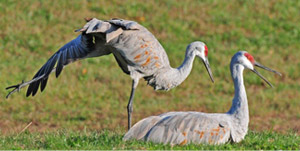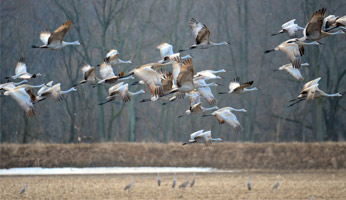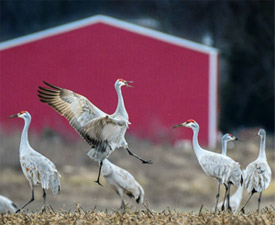 Sandhill Cranes (Antigone canadensis) are large-bodied birds with long necks, legs, and bills. They are a social species that will forage and roost in large numbers, especially during migration and winter. In the fall, you can often find them flying overhead with their distinctive bugling calls.
Sandhill Cranes (Antigone canadensis) are large-bodied birds with long necks, legs, and bills. They are a social species that will forage and roost in large numbers, especially during migration and winter. In the fall, you can often find them flying overhead with their distinctive bugling calls.
General Characteristics
Physical Characteristics
- Sandhill Cranes have gray bodies, red crowns, and white patches on the cheeks.
- The red crown is made of bare skin that develops in a bird’s second year of life.
- Sandhill Cranes stand 3 feet tall and have a wingspan of 6 feet.
- Juveniles have gray and rusty brown bodies without the red crowns.
- Sandhill Cranes look similar to Whooping Cranes (Grus americana), a larger relative, and can be found associating with them. It is very important not to confuse these species because whooping cranes are protected as a federally endangered species in Indiana. Whooping Cranes are mostly white and have black wing tips.
Behavioral Characteristics
 The Sandhill Crane’s long rolling call and unique tone is due to anatomy—they have long windpipes that coil into the chest, which causes their low pitch.
The Sandhill Crane’s long rolling call and unique tone is due to anatomy—they have long windpipes that coil into the chest, which causes their low pitch.- Cranes mate for life, choosing partners based on courtship displays, like bowing, dancing or the vertical toss, i.e., when a male grabs a clump of grass and throws it into the air with his neck outstretched.
- They migrate in groups that can reach up to the tens of thousands.
- They attack aerial predators by leaping in the air and kicking.
Distribution and Abundance
Sandhill Cranes migrate through Indiana and some breed in the state's northern counties. During migration, large flocks stopover at Goose Pond Fish & Wildlife Area and Jasper-Pulaski Fish & Wildlife Area. They can also be found foraging in agricultural fields during the day.
Reproduction
Sandhill Cranes usually nest in small, isolated wetlands or near the edge of larger wetland areas. They build their nest in vegetation such as cattails, sedges, burr reeds, bulrushes, or grasses. Nests may be 30 to 40 inches wide and 4 to 6 inches high.
They usually lay 1-3 eggs, once a year. The incubation period is 29-32 days. Eggs are pale brownish yellow to olive with brown or gray markings.
Food Habits
Sandhills are omnivores. They eat:
- Seeds and grains
- Berries
- Nuts
- Tubers
- Small vertebrates (e.g., mammals, reptiles, nestling birds)
- Small invertebrates (e.g., crayfish, earthworms)
 Conservation and Management
Conservation and Management
Sandhill cranes are one of more than 750 nongame species in Indiana. Nongame species are conserved and managed by the DNR Division of Fish & Wildlife’s nongame staff. Also, several Division of Fish & Wildlife properties have ideal habitat for sandhill cranes that also benefits many other species. Consider donating to the Indiana Nongame Wildlife Fund to support sandhill crane conservation and management.
Landowners or lessees can contact their local district wildlife biologist if a Sandhill Crane is causing damage. Special permits are required before a Sandhill Crane can be removed.
